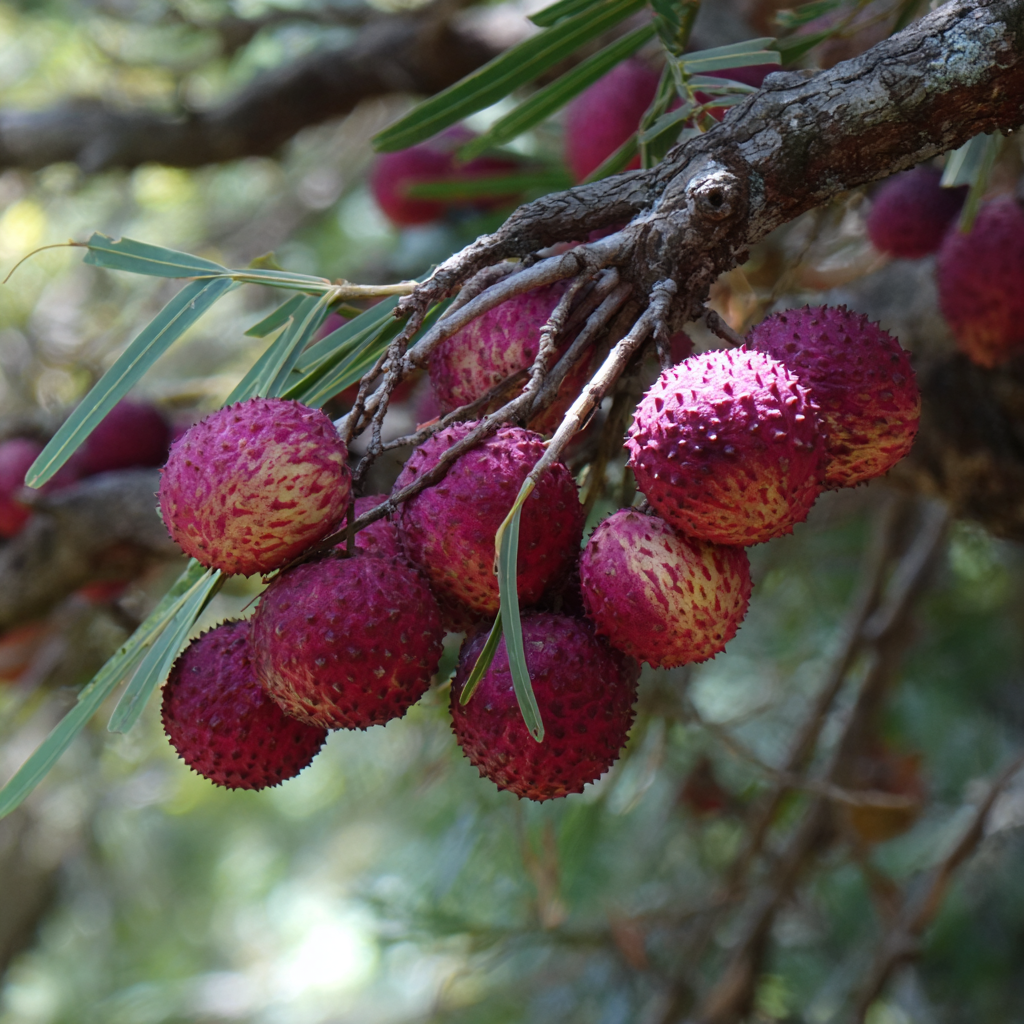Vaca Fruit
The loss of the gnomish empire of Carda cost Tairos a great deal, lives, history, perhaps even a means to have stopped The Autumn Queenbefore the disastrous Rebuke. Yet, even beyon these obvious losses, there are countless small details and delights that are lost to Tairosnow. One such pleasure is Vaca fruit.
This fruit is one of the many delights the Gnomesbrought with them on their journey Tairos. These fluorescent pink fruits with prickly exteriors grew on tall trees found all through Carda's territory. The trees had long, narrow trunks, similar to those of tropical varieties, but their branches and leaves were more akin to those of pine trees than to those of typical fruit-bearing plants. The shell of these fruits was leathery and tough like the many citrus plants of Far Harbor, requiring a good knife and a bit of force to slice through. The flesh inside was a faint yellow when freshly picked, and it darkened as it ripened. Fresh Vaca was said to have a taste like a sugary lemon, which many gnomes preferred with their breakfast. Once ripened, the flesh became rather custard-like in consistency and even sweeter. This ripe version was favored by children and by chefs seeking something sweet to fill pastries, pies, and as the basis for ice creams.
Vaca fruit was one of the few wonders that managed to escape their secretive empire and enter the wider world, albeit very sparingly. While there are no known efforts to raise the fruit outside of Carda's borders, samples of the fruit would find their way into many of the great cities thanks to gnomish traders. So rare were these exotic fruits that a single piece could often sell for several aurins. Chefs and mixologists would strive to create extracts and syrups that captured some of the essence of the fruit, too. Come the Queen's War Vaca Fruit was largely forgotten about, and what little extract and syrup remained was used up quickly. Only at the war's end, when the gnomes' youngest generation were escaping Carda, was Vaca briefly reintroduced. The children were given considerable amounts, both as a treat to calm their nerves and as a trade good. This small supply was quickly depleted too, lasting only a few weeks, from this point on Vaca fruit faded into memory, becoming just another thing that exists only as a historical footnote.
However, as explorers now return to the ruined empire and its border regions, they're beginning to rediscover the fruit. Seeds from the old orchards have taken root and grown wild in many areas. These explorers, often tomb raiders more eager to steal and exploit than explore, are largely ignorant of what the fruit is or the importance it played in the lives of the gnomes. For them, it's just a tasty treat to supplement their camp supplies.
Mechanics & Inner Workings
The interior of the fruit is entirely edible. A tougher pith rests in the center that can be difficult to eat and is often discarded. This pith holds the small, squishy seeds. The seeds themselves are also perfectly edible.
Manufacturing process
Vaca appears to thrive in cooler climates where water is abundant. Pollinators like bees are required to help the trees bear fruit and prosper.
History
Some old texts describe fanciful baked goods brought by gnomish traders that contain the fruit. Many of these simple news articles, letters, and periodicals are gathered in Homestead, where gnomish historians do their best to piece together anything of their past, including their culinary pursuits.
Significance
Prior to the fall of Carda, Vaca fruit was a staple in almost every home and beloved by most of its citizens. Much like prized hunted game in Frostmere, the golden-hued peaches of Balmoral, or the ales favored by Ghal Ankhar this fruit is as much a symbol of pride and prosperity as it is just a piece of food.
Item type
Consumable, Food / Drink
Current Location
Rarity
Vaca is now incredibly rare. Most are unaware of its existence, and many others assume it's extinct. Culinary connoisseurs would pay handsomely for a genuine piece, though.
Weight
8 oz


Comments